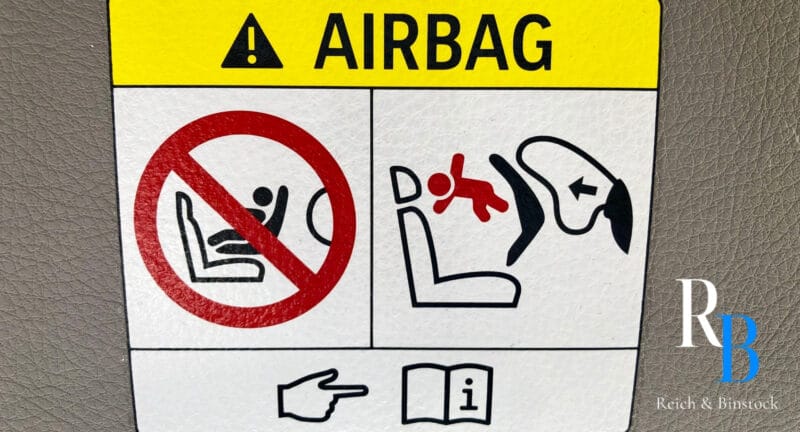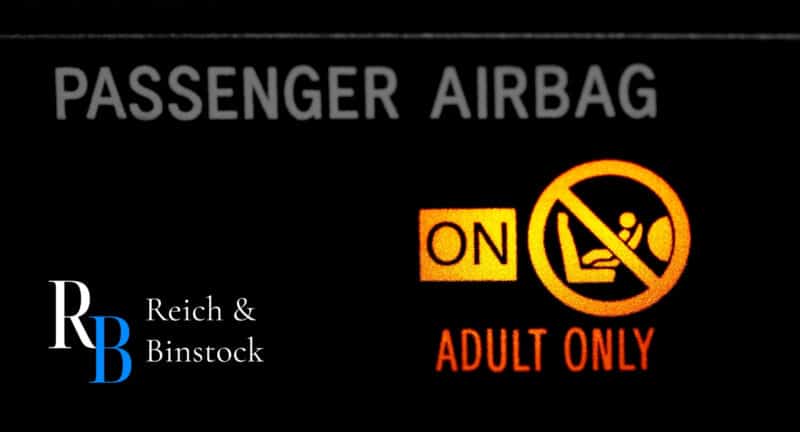AIRBAG INJURIES AND DEFECTIVE AIRBAGS
Defective Airbag Attorney Houston

When you think of airbags, you probably think of lifesaving devices. However, many people suffer injuries from these very cushions every year. In fact, certain car brands have experienced serious airbag recalls in the past. These recalls exist only after numerous injuries or deaths occur due to improperly functioning airbags. Not only do airbags cause injury when they malfunction, but they also cause injury when they work properly.
At Reich & Binstock of Houston, we understand that unexpected car accidents happen. That doesn’t mean you should just accept the serious injuries you sustain from your airbags. Sometimes, airbag malfunctions have specific causes, such as manufacturing oversights. We’re here to fight for your just compensation in these cases. If you or a loved one suffered serious injury or even wrongful death due to airbag deployment, you need our experienced Houston personal injury lawyers. Call 713-622-7271 today for your free consultation.
Defective Airbag Injuries in Car Accidents
Unfortunately, burn injuries and fatal injuries are a possibility when an airbag goes off after a car accident. Even safety devices such as seat belts and frontal airbags could cause catastrophic injury if the airbag manufacturer or another party were negligent. In most cases, airbags save lives, prevent traumatic injuries, and save countless lives. In rare cases, however, they are the source of the injuries. If negligence is introduced into the process of producing, manufacturing, designing, installing, or maintaining an airbag, this could cause injury down the line.
Motor vehicle accident victims could face the following issues due to defective airbag systems:
- Chemical burns
- Thermal burns
- Broken bones
- Asthma attacks
- Cutaneous burns
- Other injuries related to airbag deployment
If you or a loved one suffered airbag-related burns or other injuries caused by airbags, you might have a valid personal injury claim. Contact our Houston personal injury lawyers as soon as possible for a free case evaluation. After any type of car accident, it’s important to keep an eye out for delayed concussion symptoms.
What Is a Defective Airbag?
Defective airbags are those which have manufacturing defects, design flaws, or other issues that compromise the safety and proper functioning of the airbag. One famous example of faulty airbags is the Takata airbags recall.
The main issues in those cases were two major flaws:
- The propellant agent used in the inflator is ammonium nitrate, which is an extremely flammable and combustible material.
- There is no drying agent in the airbag to absorb moisture.
Why are these two facts indicative of defective airbags in Takata’s case? The ammonium nitrate used in the airbags is a chemical that degrades if exposed to moisture. Degradation of ammonium nitrate can lead to a massive explosion when the crash sensor triggers airbag inflation. This explosion could completely shatter the airbag inflator mechanism. Any shrapnel created from the explosion could cause lacerations, cuts, bruises, severe injuries, and fatal injuries.
Other common airbag defects that tend to result in injuries include the following:
- Late deployment, which can make airbags unable to protect drivers
- Complete failure to deploy, which can result in serious harm to passengers
- Unexpected or premature deployment
How Do I Know if an Airbag Is Defective?
There are a few ways to protect yourself from burn injuries related to a faulty airbag. One common way is to check the website of the National Highway Traffic Safety Administration to see if your brand of airbag malfunctioned for others. If so, it is likely that the airbag has been recalled and could be replaced for free.
You and your Houston product liability attorneys must be able to establish a connection between your chemical burns or other injuries and the faulty deployment of the airbag. Additionally, to check the current status of the airbags in your vehicle, you can run an airbag diagnostic test. This test will check the crash sensor and circuits before flashing lights to notify you of any issues.
How Common Are Airbag Malfunctions?
Sadly, over 3 million vehicles have been recalled due to airbag defects since 1997. That’s about 120,000 each year if divided evenly. The issues are also spread across a wide array of auto manufacturers. Approximately 50 different manufacturers have recalled at least one of their models for defective airbags. Some of these popular vehicle brands include General Motors, Nissan, Toyota, Hyundai, Ford, and BMW. For more information about malfunctioning airbags, visit the National Highway Traffic Safety Administration website.
Can You Sue a Car Company for Airbags Not Going Off?
Yes, in specific situations. In fact, it is possible that multiple parties could be held liable for the failure of the airbags. Common airbag injuries can result from both deployment and lack of deployment. Both are valid injury claims as long as you can prove a connection between the injuries and the airbags.
Airbag Deployment
When Do Airbags Deploy in an Accident?
We all know that airbags deploy after a car crash. But, how exactly does airbag deployment work? These inflatable cushions reside inside strategic parts of your vehicle, like the steering wheel or dash. Airbag deployment aims to protect you from both the vehicle’s hard interior and objects outside the vehicle. When a crash occurs, sensors placed around the outside of your vehicle measure the severity of the impact.
If the sensors determine the crash to be severe enough, they send signals to the inflators, which deploy the airbags almost instantaneously. In most cases, airbag deployment is the only reason someone needs airbag maintenance. Once they deploy, they must be replaced with parts from the original manufacturer of your vehicle. This ensures that any new airbags are fully functional and not potentially counterfeit or dangerous.
What Happens When an Airbag Deploys?
Your airbag just deployed. Now what? We recommend taking certain steps after airbag deployment in order to ensure your own safety, as well as the safety of your passengers. Below, we include four steps to take after airbag deployment:
Check yourself and others for injuries. If you remain conscious after the crash, check yourself for injuries. After an automobile accident, health and safety are the top priorities. If you find injuries to yourself or others, seek medical attention, if possible.
Turn off your engine. In most modern vehicles, airbag deployment automatically turns your engine off. However, if this mechanism fails or if your car is older, make sure that you turn the engine off. This protects you and your passengers from possible explosions.
Assess the damage. Examine the vehicle and take detailed pictures of the damage. Call the police, as they will write a report about the crash. Contact your attorney, as well as your insurance company about the crash.
Replace the airbags. Go to your trusted mechanic for airbag replacements. In cases of airbag deployment, it is highly possible that your vehicle was totaled. Speak with your insurance company and mechanic about the damages to determine your next course of action.
What are Common Airbag Deployment Injuries?
Crashes involving airbag deployment result in a wide range of injuries, varying in severity. Even though airbags protect more than they harm, they still result in some degree of harm for many people. Below, we list some common airbag deployment injuries:
- Abrasions
- Contusions
- Burns
- Sprained fingers or wrist injuries
- Spine injuries
- Fractures to bones, including the skull, rib cage, or arms
- Concussions
- Lacerations
- Asthma attack triggers
- Airbag dermatitis, or skin irritation
- Eye injuries
- Ear trauma, including hearing loss
- Internal bleeding
- Fetal injury to pregnant women
As we see above, the type and severity of airbag deployment injuries vary greatly. Any of the above injuries have the potential to be severe or even fatal. In order to reduce your risk of serious injury, always position your seats at least 10 inches away from the airbag deployment area.
How Long Does It Take to Heal from Airbag Injuries?
This depends on a number of factors, including the type and severity of the injury. Most superficial wounds of the skin should heal fully or almost fully after around 10 days. However, this amount of time could be lengthened if infections occur.
For those who experience chest pain after their motor vehicle accidents, they may have a bruised sternum. Depending on the severity of the bruising, it could take anywhere from two to four weeks to fully heal. For back and spinal cord injuries, it may take as long as 16 weeks or longer if surgical intervention is necessary.
Can You Be Killed by an Airbag?
Yes. Not only can people suffer serious injuries from airbags, but it is also possible for defective airbags to be fatal. Airbags fully inflate in a matter of milliseconds. That means they exert an extreme amount of force while deploying. Those who are most at risk during car crashes are children and adults who are very small. The best way to mitigate any unfortunate consequence that could result from an airbag is to always adhere to airbag safety guidelines, especially when children are involved.
How Do You Treat an Airbag Burn?
Burn injuries caused by airbags require a certain level of aftercare, even if the burns are minor. The speed and force exerted when the airbag is deployed could result in thermal injury from hot gases, friction, and shrapnel. Burn management is crucial for auto accident victims, as you don’t want to risk infection.
After doctors have all patients evaluated after an accident, they can begin to administer burn care. This will likely involve keeping the wound covered, clean, and dry. Patients can also take emergency medicine for pain, redness, swelling, and inflammation. As soon as possible, all patients should have their burn characteristics evaluated by a medical professional. This will help ensure that all burns resulting from the accident are treated properly.
How Does Airbag Deployment Work?
Airbag deployment is a fairly complex process that happens in the blink of an eye. In order to understand airbag deployment, you’ll first need a basic knowledge of how the crash sensors work. These small electronic devices determine when your vehicle suffers damage. They take in different stimulus types, like sudden stopping or increased pressure. Other sensors also measure seat occupant status (belted or unbelted), wheel speed, and even brake pressure. These sensors send signals to the airbag deployment control unit and determine when to deploy.
Next, the inflator- this system receives the deployment signals. It sets off a chemical reaction, which then produces nitrogen gas. This gas fills the airbag at extreme speeds, causing it to burst through its container and into the vehicle’s interior. Within 25 to 50 milliseconds of the crash, your airbag deploys. With that amount of force and speed, it’s no wonder that airbag deployment can lead to injuries.
How to Prevent Airbag Injuries
There are several safety measures to take if you want to reduce or prevent your risk of airbag injuries. Most of the precautions are common vehicle safety practices that also reduce your risk of airbag injuries:
- Wear a seatbelt. Failing to wear a seatbelt is illegal in the state of Texas. This is due to the life-saving essentiality of seatbelts. Every single passenger in a vehicle, including children, must wear a seatbelt. Not only do they protect you from ejection and hitting the inside of your car, but they also protect your body from moving too close to the airbag deployment area.
- Sit as far from the steering wheel as you can, within reason. Positioning your seat at least 10 inches away from the deployment area is ideal.
- Safely restrain all children. Read up on Texas’s child restraint recommendations and ensure that all children are properly restrained in the vehicle.
- Install airbag on-off switches. Some situations involve a greater risk of airbag injuries than others. In the below cases, it may be wise to install airbag switches.
- Your rear seat is too small, so you place a rear-facing infant restraint system in the front seat. Airbags pose a large risk to infants, so turning them off is generally safer.
- A child under 13 years of age is riding in the front seat because of a medical condition where they must be frequently monitored.
- You have a medical condition that has increased risks when it comes to airbags.
- You are short of stature, and, therefore, must sit closer to the deployment area in order to drive.
- Do not drive while pregnant. If at all possible, pregnant individuals should not drive. Airbags pose great risks to the fetus and should be avoided.
What to Do After Being Injured by an Airbag
After any crash, the first step is always to check yourself and your passengers for injury. In cases where you believe the airbag deployment to be related to faulty parts, keep the airbag in your possession. Do not allow any parts to be removed from the vehicle. Your attorney, while building your case, will want access to safety devices like the airbag itself, the crash sensors, and the inflators. Having these items makes personal injury cases easier in court. Next, discuss your plan of action with your attorney. It is important to pursue your claim sooner rather than later, as this also helps your case in court.
Who Is Liable for Airbag Injuries and Airbag Burns?
Several potentially responsible parties exist when it comes to common injuries from airbags. Depending on the circumstances of your specific case, you could hold multiple parties accountable for your losses, including the following.
- Another driver acting negligently
- Manufacturer of the airbag
- Seller of the airbag or vehicle
- Mechanic or vehicle repairman
- Manufacturer of the automobile
- Inspectors of airbags
What Damages Can I Recover for Airbag Injuries in Texas?
As with other types of personal injury cases, it’s important to understand approximately how much you can recover in a defective airbag lawsuit. Victims of defective airbags deserve compensation for their injuries, and a fair settlement amount is what any good attorney should fight for. If you suffered one of the common airbag injuries we mentioned above, you might have a case.
You may be eligible for compensation for the following:
- Current and future lost wages
- Current and future medical bills
- Costs for modifications to the home or vehicle
- Emotional distress
- Pain and suffering
- Temporary or permanent disability
- Loss of consortium
- Loss of quality of life
Houston Airbag Injury Lawyers
If you or a loved one sustained injuries due to airbag deployment, you need the Houston car accident lawyers at Reich & Binstock. You only have a limited amount of time to make your claim, so we recommend acting fast. We offer caring and compassionate counsel to victims of car accident injuries at our law firm. While you focus on recovery, we’ll focus on the legal aspects of your case. To schedule your free consultation with us, please call 713-622-7271 today.
There is never a fee unless we recover on your behalf.
Additionally, clients are not obligated to pay expenses if a recovery is not made.



























